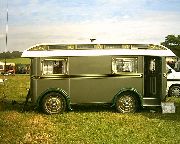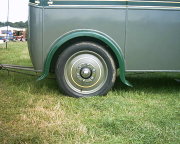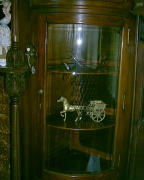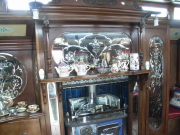LATE 1920s ECCLES "FORTUNE TELLERS WAGON"
In the late 1920s, wagons were generally getting bigger and bigger so this one which was built by the Eccles company was a departure from the trend. Other manufacturers like Hills and Brayshaws also saw a gap in the market for a small wagon that could be towed by a large family saloon car instead of the steam traction engines and powerful lorries usually required. As well as four wheeled wagons some manufacturers also made two wheel versions.
This appealed to the people who did not have any equipment to cart around and fortune tellers fell into this category. They usually only had a pack of cards, a crystal ball and sometimes a bird in a cage which was trained to pull cards from a pack with predictions on them. The birds would probably be Chaffinches or a similar species. These birds would live in a cage outside of the wagon but would be brought in for travelling. True fortune tellers are not really showmen at all, they are Romanies but the large crowds that attended the fairgrounds between the wars made it the ideal venue for them to ply their trade. So you had the situation of Romanies using wagons designed for showmen instead of their usual Gypsy wagons. Although not specifically manufactured for them, these wagons are still widely referred to as "fortune tellers wagons".

These little wagons had all of the style of the much larger more expensive wagons and the interiors had lots of cut glass mirrors and display cabinets. In order to reduce the height, Ackerman steering was used which is the same as that on a car where the wheels turn individually on stub axles unlike the big wagons where the wheels are both on the same axle and turn together on a turntable. This wagon was originally owned by a showman named Owen Smith, it later belonged to living wagon decorator John Pockett. It had a spell of several years with Michael Leigh and is currently owned by Julian Wolfe (who also owned the Orton wagon that I made).
There was another wagon that I used for reference when I first started the Eccles and that was owned by Chris Sales but he decided to sell it shortly after I started my model. Chris sold his wagon to Gordon Boswell and it can now be seen in the Romany Museum in Spalding, Lincolnshire.
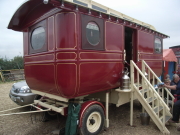
During my visit to the Dorset Steam Fair (2008), I came across a very pretty 18ft Brayshaw living wagon (photo) and the cut glass was almost identical to that in the Eccles that I built. (photos). When I mentioned this to the owner, he said that Eccles had copied their version from Brayshaw. To date, I have not been able to confirm this but it does make sense, as the Brayshaw was built at least seven years earlier than the Eccles. Both wagons are very desirable.
